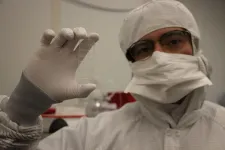(Press-News.org) New medicines for people who have diabetes seem to pop up all the time. Drugs that help the body break down carbohydrates, drugs that increase excretion of glucose in the urine, drugs that help muscles respond to insulin and drugs that stimulate the pancreas to produce it -- the list of pharmaceutical options to treat diabetes gets longer and longer.
The downside of this wealth of treatment options is that it can be difficult for health care providers to stay on top of the latest research and standards of care. Which medication is best for which patients? And what are the best medicines to prescribe that both lower blood glucose and reduce risk for cardiovascular disease?
Johns Hopkins Medicine endocrinologist and associate professor Rita Rastogi Kalyani, M.D., authored a clinical practice review article in the April 1 edition of The New England Journal of Medicine (NEJM) that distills the newest trial results and guidelines into a systematic approach for treating patients with diabetes and a risk of cardiovascular disease. Kalyani's article is the first clinical practice review that the journal has published on diabetes management in almost a decade.
Different from research studies, clinical practice reviews present a common clinical problem and the evidence supporting various treatment strategies, followed by a review of the guidelines and the author's clinical recommendations to optimize patient care.
People who have type 2 diabetes are more than twice as likely to develop atherosclerotic cardiovascular disease and heart failure than people who don't have the disease. The NEJM article presents an up-to-date approach for health care providers when choosing among glucose-lowering therapies for their patients with diabetes, particularly to reduce the risk of cardiovascular disease.
"We've seen a major shift in diabetes care over the past few years," says Kalyani. "We now have tools to better understand how to reduce both microvascular and macrovascular complications in people with type 2 diabetes."
The article examines the cardiovascular benefits and risks of the most commonly used drugs for diabetes that are currently available on the U.S. market.
Kalyani lists specific agents in two newer drug classes as beneficial for patients with diabetes who already show signs of heart or blood vessel disease.
The glucagon-like peptide 1 (GLP-1) receptor agonists liraglutide, injectable semaglutide and dulaglutide increase insulin production from the body, particularly after meals.
Sodium glucose cotransporter 2 (SGLT2) inhibitors empagliflozin and canagliflozin reduce the amount of glucose the body re-absorbs through urine.
All are effective at helping patients reduce the chance of having a major cardiovascular event, such as heart attack or stroke. The SGLT2 inhibitor, dapagliflozin, is effective at helping reduce the chance of hospitalization for heart failure.
"After metformin, which is widely considered the initial drug treatment for type 2 diabetes, specific drugs in the GLP-1 receptor agonist and SGLT2 inhibitor classes with demonstrated cardiovascular benefit should be considered as additional medications for patients who already have cardiovascular disease. This should be done irrespective of whether their A1C level is at target to reduce the risk of future cardiovascular events," says Kalyani, referring to the hemaglobin A1C test, which measures a patient's average blood glucose level over three months.
Sugar attaches to a protein in red blood cells that carries oxygen to organs and tissue and that transports carbon dioxide to the lungs. The A1C test measures the average percentage of glucose in a person's hemoglobin over the span of several months. Healthy A1C levels are below 5.7%. Generally, A1C levels higher than 6.5% indicate diabetes.
Kalyani notes that the newer drugs tend to be more expensive, and long-term effects are unknown. Before 2008, the U.S. Food and Drug Administration the agency that regulates the pharmaceutical industry -- did not require large outcome trials for drugs after their introduction to the market. As a result, says Kalyani, the cardiovascular effects of older drugs remain less certain.
The NEJM article details specific drugs that offer additional benefits for patients with diabetes who have conditions such as multiple cardiovascular disease risk factors, heart failure and chronic kidney disease.
"Some agents such as dulaglutide and dapagliflozin also have demonstrated cardiovascular benefit in patients with multiple cardiovascular risk factors," Kalyani says.
Further, specific SGLT2 inhibitors can be beneficial for patients who have heart failure with reduced ejection fraction -- a condition in which the heart muscle doesn't pump blood efficiently -- as well for patients with chronic kidney disease.
The article includes comprehensive drug tables that include the factors to consider in clinical practice when choosing a glucose-lowering drug for patients with type 2 diabetes, including A1C-lowering efficacy, route and frequency of administration, cost, effects on weight, risk of hypoglycemia, side effects and clinical benefits.
"Health care providers in primary care, endocrinology, cardiology and nephrology are now prescribing these newer glucose-lowering drugs for their patients," Kalyani says. "Diabetes care will need to be increasingly collaborative in the future and, at its core, remain patient-centered."
INFORMATION:
Kalyani was previously the chair of the American Diabetes Association's Professional Practice Committee, which annually updates the Standards of Medical Care in Diabetes, the organization's clinical practice recommendations. She has also co-authored clinical guidelines published by the Endocrine Society and the American College of Cardiology.
The author reports no industry conflicts.
How many species of birds are there in the world? It depends on whose count you go by. The number could be as low as 10,000 or as high as 18,000. It's tough to standardize lists of species because the concept of a "species" itself is a little bit fuzzy.
That matters because conserving biodiversity requires knowing what diversity exists in the first place. So biologists, led by University of Utah doctoral candidate Monte Neate-Clegg of the School of Biological Sciences, set out to compare four main lists of bird species worldwide to find out how the lists differ--and why. They found that although the lists agree on most birds, disagreements in some regions ...
A new analysis of lung epithelial cells from COVID-19 patients reveals how the protective complement branch of the immune system, which usually plays roles in both innate and adaptive immunity, can convert to a harmful system during COVID-19. Blocking excessive complement activity in lung epithelial cells with a combination of existing chemotherapy and antiviral medications - ruxolitinib and remdesivir, respectively - helped normalize the production of complement proteins by infected lung epithelial cells in human cell culture experiments, the researchers found. Thus, the drug duo could serve as a promising strategy to treat damaging inflammation during severe COVID-19, the authors say. Overactivation of complement proteins can contribute to diseases such as acute respiratory distress ...
HERSHEY, Pa.-- Social distancing and lockdowns may have reduced the spread of COVID-19, but researchers from Penn State College of Medicine also report those actions may have affected clinical researchers' ability to finish trials. Study completion rates dropped worldwide between 13% and 23%, depending on the type of research sponsor and geographic location, between April and October 2020.
Researchers previously reported that more than 80% of clinical trials suspended between March 1 and April 26, 2020, noted the pandemic as their chief reason for halting activity. Patient enrollment in studies was lower in April 2020, compared to April ...
WYOMISSING, Pa. -- Teaching people to become entrepreneurs requires more than just passing on entrepreneurial skills, according to a team of Penn State Berks-led researchers. Would-be entrepreneurs also need to understand -- and negotiate -- the barriers that they might face.
In a study, researchers built a multidimensional model to measure the effectiveness of entrepreneurship education. The model not only includes teaching entrepreneurial skills, but also addresses the students' intentions to start a business and their perceptions of the barriers they might encounter when starting a business.
"There are a lot of studies in the literature that focus on, for example, how entrepreneurship education ...
HOUSTON -- (April 7, 2021) -- Rice University computer scientists have demonstrated artificial intelligence (AI) software that runs on commodity processors and trains deep neural networks 15 times faster than platforms based on graphics processors.
"The cost of training is the actual bottleneck in AI," said Anshumali Shrivastava, an assistant professor of computer science at Rice's Brown School of Engineering. "Companies are spending millions of dollars a week just to train and fine-tune their AI workloads."
Shrivastava and collaborators from Rice and Intel will present research that addresses that bottleneck April 8 at the machine learning systems conference MLSys.
Deep neural networks ...
In an article published in the April 8 issue of Nature, the National Institutes of Health's Somatic Cell Gene Editing Consortium provided a detailed update on the progress of their nationwide effort to develop safer and more effective methods to edit the genomes of disease-relevant somatic cells and reduce the burden of disease caused by genetic changes.
Gene editing allows scientists to modify sections of an organism's DNA and is considered a promising treatment for a number of genetic diseases. There have been numerous advances in the laboratory over the last few decades, but there are still many challenges to overcome before gene editing can be widely used in the patient population. Launched in 2018, the Somatic Cell Gene Editing Consortium ...
A natural brilliant blue coloring has been discovered by an international team of researchers including chemists at the University of California, Davis. The new cyan blue, obtained from red cabbage, could be an alternative to synthetic blue food colorings such as the widely used FD&C Blue No. 1. The work is published April 7 in Science Advances.
"Blue colors are really quite rare in nature - a lot of them are really reds and purples," said Pamela Denish, a graduate student working with Professor Justin Siegel at the UC Davis Department of Chemistry and Innovation Institute for Food and Health.
Having ...
Scientists have developed a long-sought naturally derived cyan blue colorant sourced from red cabbage anthocyanin pigments that may offer an alternative to the industry standard blue dye, although more testing is needed to determine the compound's safety. The novel colorant, which was developed using an enzyme that converts a range of anthocyanins to one with the ideal wavelength, remains highly stable over time and may also produce better green colors than those derived from existing natural blue colorants. Several research programs around the world are dedicated to the hunt for a natural alternative to FD&C Blue No.1 - a challenging effort given that cyan blue is one of the rarest colors in nature. While previous research has shown that ...
DURHAM, N.C. -- An interdisciplinary team of scientists at Duke University has developed a highly sensitive and rapid diagnostic test for Ebola virus (EBOV) infection. In monkeys infected with Ebola, this diagnostic, called the D4-assay, proved to be 1000 times more sensitive than the currently approved rapid diagnostic test and capable of detecting the virus a full day earlier than the gold standard polymerase chain reaction (PCR) test.
This work, which appears in Science Translational Medicine on April 7, was done by biomedical engineers, molecular ...
Progression of Duchenne Muscle Dystrophy (DMD) can be delayed in mice by supplementing their diets with Urolithin A, according to new results reported today. The findings, published in Science Translational Medicine, raise hopes that new treatment options could one-day be developed for DMD, an uncurable genetic condition characterized by progressive muscle degeneration. About 1 in 3,500 boys are born with DMD, which usually develops in childhood and significantly reduces life expectancy.
The new research carried out at the laboratory of Professor Johan Auwerx, ...




